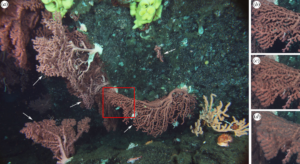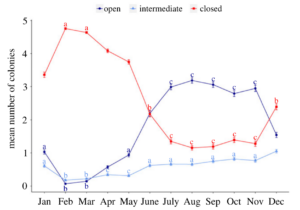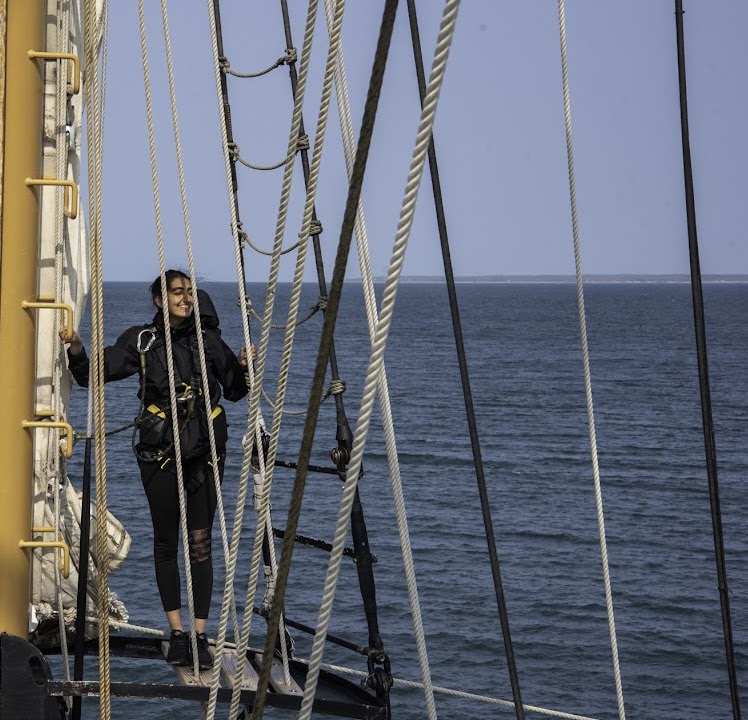Girard, Fanny, et al. “Phenology in the deep sea: seasonal and tidal feeding rhythms in a keystone octocoral.” Proceedings of the Royal Society B 289.1985 (2022). https://doi.org/10.1098/rspb.2022.1033
Deep sea coral ecosystems exist in the darkest depths of the ocean (further than 200 meters below the sea surface), and are some of the most diverse regions of the deep ocean. Deep sea coral species rely on dead and decayed food that sinks to them from the sea surface via the oceanic biological pump; because of this, their feeding behaviour varies with the time of day, with the seasons and even with the tidal currents!
Studying such temporally variable phenomena (known as phenology) in deep sea coral can inform us how environmental change affects organisms living in the deep ocean. In their paper, Girard et al. investigate how a deep sea ‘bubblegum’ octocoral, Paragorgia arborea, changes its feeding behaviour with changing food availability and currents at the sea surface over time.
Deep Sea Exploration
In this study, the authors deployed a time-lapse camera at a depth of 1230 meters in Sur Ridge, California, to observe the feeding behaviour of P. arborea. This deep sea coral, also known as the bubblegum coral, is a filter feeder; this means that it captures organic matter in the water by extruding the coral polyp and extending its tentacles (open polyps). When organic matter is scarce, the polyps retract (closed polyps) to conserve energy for when food becomes available again.
For this paper, the authors used open/closed polyps as a proxy for higher/lower feeding activity respectively. For the food availability, the authors used net primary production (NPP) as a proxy; NPP is the amount of organic matter being produced by primary producers in the surface ocean. They also used Acoustic Doppler Current Profilers (ADCPs) to measure current speed and direction in the ocean.

A Long-Distance Relationship
So how do diurnal and seasonal changes at the surface ocean affect organisms living almost a mile below?
The researchers found that the number of open polyps was the greatest and the number of closed polyps was the least in the summer months (from June to November) and the opposite was seen for the winter months.

It was found that the higher the NPP at the ocean surface (which occurs in the summer months), the greater was the number of open polyps. Thus, they showed that food availability in the surface ocean affects the feeding behaviour of an organism that lives at more than a thousand meters depth in the ocean!
They also were able to show that the diurnal tidal cycle at the ocean surface affects feeding behaviour by altering ocean currents. The change in speed and direction of the currents leads to changes in food delivery from the surface ocean to the deep ocean, which in turn affects deep sea coral feeding behaviour.
Climate Change and the Deep Ocean
With our rapidly changing climate, it may seem that the deep ocean coral is protected by thousand meter layer of water. But that is not the case. The surface ocean NPP is being drastically affected by ocean warming, acidification and deoxygenation; and we now know that deep sea coral are highly reliant on surface NPP for their food. The negative impact of climate change on the surface ocean will most definitely affect the functioning of deep sea coral ecosystems.

I am a PhD student at the University of Chicago and the Marine Biological Lab, currently studying germline development and regeneration in the amphipod crustacean, Parhyale hawaiensis. I did my undergraduate degree in India and did my Masters in Oceanography at the University of Massachusetts (during which I participated in multiple month-long research cruises out in the Pacific and Atlantic Ocean!). I am broadly interested in integrating ecology with developmental biology in marine organisms and I hope to comprehend the fundamental interconnectedness of the mysteries that swim in the Earth’s oceans. I am also an illustrator and a PADI certified diver.

